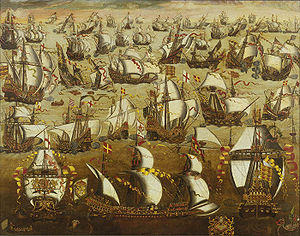HMS Aid (1562)
 English ships fight the Spanish Armada, 1588 | |
| Career (England) | |
|---|---|
| Name: | Aid or Ayde |
| Builder: | Deptford Dockyard |
| Launched: | 6 October 1562 |
| Honours and awards: |
Participated in: |
| Fate: | Broken up in 1599 |
| General characteristics | |
| Type: | Armed ship |
| Tons burthen: | 300 burthen |
| Propulsion: | Sails |
| Armament: |
18 guns
|
Aid or Ayde[Note 1] was an 18-gun ship of the Royal Navy. She was built at Deptford Dockyard, being launched on 6 October 1562. She was rebuilt in 1580 and was broken up in 1599. For the majority of her service, she was commanded by Sir Martin Frobisher.
Contents
Service History
Le Havre (1562)
Aid was one of three ships built in 1562 due to the threat of war with France. Her first duty, in autumn of that year, was to help supply the English garrison at Le Havre.[1] This continued until the port was captured by French loyalist forces from the Huguenots in August the following year.[1]
Expedition to the Northwest Passage (1577)
The ship's next major duty was in 1577, when the ship was granted to Martin Frobisher as part of his second expedition what is now the far north islands of Canada.[2] The expedition was made up of the Aid, commanded by Frobisher, and two barks, the Gabriel and the Michael, commanded by Edward Fenton and Gilbert Yorke respectively.[3] The fleet, consisting over about 120 men, departed Harwich on 31 May 1577.[3] The expedition brought back 200 tons of ore,[1] although the value of this was less than Frobisher's investors had hoped.[2] They also brought back a family of Inuit, but all three; man, woman and her child, died within a month of arriving in England.[1]
Second expedition to the Northwest Passage (1578)
Another voyage ensued, with Frobisher this time taking some fifteen vessels to explore the Northwest Passage, mine ore and establish a manned settlement in the area.[1] The journey was tough, with strong winds and thick ice preventing them from travelling beyond the Hudson Strait, [2] and they returned to Frobisher Bay.[1] There, Aid was hulled below the waterline by an ice floe, requiring repair by a sheet of lead.[1] They abandoned plans to establish a settlement in the area and returned to England with over 1,000 tons of ore.[1]
Anglo-Spanish War (1580s)
Aid was rebuilt in 1580 as relations with the Spanish deteriorated.[1] Under the command of Frobisher, Aid was involved in the Siege of Smerwick, as part of the English fleet sent to remove a combined Spanish-Papal force taking refuge at Dún an Óir.[1] Remaining under Frobisher's command, Aid was one of two ships contributed by Queen Elizabeth I to Sir Francis Drake's expedition to the Spanish West Indies in 1585.[1] She was later part of Drake's fleet at Plymouth to meet the Spanish Armada, remaining with the fleet from the arrival of the Armada on 31 July until the defeat of the Spanish at the Battle of Gravelines, eight days later.[1] The Aid was also involved in the ill-fated Counter Armada the following year.[1]
Notes
- ↑ 1.00 1.01 1.02 1.03 1.04 1.05 1.06 1.07 1.08 1.09 1.10 1.11 1.12 Paine (2000), pp2–3
- ↑ 2.0 2.1 2.2 "Martin Frobisher". Polar Conservation Organisation. 2008-10-08. http://www.polarconservation.org/education/explorers/martin-frobisher. Retrieved 2009-11-24.
- ↑ 3.0 3.1 "Frobisher, Sir Martin". Dictionary of Canadian Biography Online. http://www.biographi.ca/009004-119.01-e.php?BioId=34352. Retrieved 2009-11-24.
References
Bibliography
- Colledge, J. J.; Warlow, Ben (2006) [1969]. Ships of the Royal Navy: the complete record of all fighting ships of the Royal Navy (Rev. ed.). London: Chatham. ISBN 9781861762818. OCLC 67375475.
- Paine, Lincoln P. Ships of Discovery and Exploration (2000 ed.). Houghton Mifflin. ISBN 0395984157. http://books.google.co.uk/books?id=kpMGlc-cvAoC&printsec=frontcover&source=gbs_navlinks_s#v=onepage&q=&f=false.
Cite error: <ref> tags exist for a group named "Note", but no corresponding <references group="Note"/> tag was found, or a closing </ref> is missing
